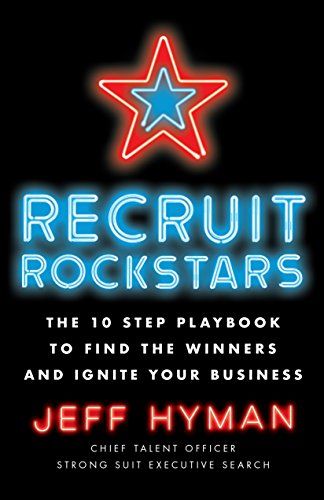As the leader of your business, one of your most important role is to build a talented team around you. This sounds easier than it actually is. The difficulty in finding rockstar team members is a struggle we all have had to deal with.
Jeff Hyman understands this problem and has identified the solutions. Hyman is a 4x entrepreneur and is also a master recruiter. He recently launched a book entitled “Recruit Rockstars: The 10 Step Playbook to Find the Winners and Ignite Your Business”.
We had the pleasure of asking Jeff some questions on building a team of A-players that will propel any business. His answers to our questions were super insightful and a must-read for any leader.
Q. Welcome to StartUp Mindset, Jeff. For our readers that are not familiar with you, could you tell us a little about yourself and your background?
I am a Professor at Northwestern University’s Kellogg School of Management, host of the 5-star-rated Strong Suit Podcast, and Chief Talent Scout at Chicago-based Strong Suit Executive Search. Along the way, I’ve created four companies that were backed by $50 million in venture capital. I launched my recruiting career at Heidrick & Struggles and Spencer Stuart, both preeminent global executive search firms. I hold a master’s degree from Kellogg and a bachelor’s degree from The Wharton School.
Q. Tell us a little bit about your new book “Recruiting Rockstars” and why you decided to write it.
My professional passion is to help companies recruit and retain top people so that they can grow and prosper. I wrote Recruiting Rockstars to help companies get better at hiring.
I strongly believe that 90 percent of business problems are recruiting problems in disguise. Organizations do not have the right people in the right places who can make the right decisions at the right time. Instead of dealing with the core issue – having the wrong people in important positions – companies go through all sorts of restructurings and strategy permutations in an attempt to right the ship.
Any sports fan knows that a team is only as good as its players. Identifying the best available players at each position should be the most critical function of every team. The same is true in business. Recruiting great people is without a doubt the most important thing a company can do to become successful.
Here’s the scary statistic. Only about 50% of new hires meet or beat the hiring manager’s expectations two years after being hired. Despite this, nearly every business executive I’ve encountered believes deep down that they’re good at assessing talent. They trust their gut. That hubris has been institutionalized, which is why in most organizations there is little discussion of the 50% hiring fail rate.
The methodology I provide in my book will enable companies to achieve a hiring success rate of 80% or more. While there will always be an element of subjectivity in hiring, my approach relies on a standardized process that is based on things that are actually predictive of success. It works.
I wrote the book because I want others to benefit from my experience. I love to see people and organizations do well. I’m confident that the book will help business owners and executives to recruit and hire better – and to enjoy a much higher level of success.
Q. In your book you write about the importance of recruiting A-players to a company. You also outline what effect B and C-Players have on a company. Could you give us a few reasons why hiring less talented individuals is more damaging to a company than most people think?
The issue with B and C players isn’t necessarily about a lack of talent. Some B and C players possess a great deal of talent. The problem is they are unable – for a variety of reasons – to perform at a high level.
B and C players require more time and attention from management in order to focus them on what needs to get done and to motivate them to work at a reasonably productive level. The time managers devote to B and C players takes away other activities that may yield greater benefits in the long run.
Generally speaking, C players are substandard performers that detract from the organization’s culture and make everyone else’s job more difficult. They can’t be relied upon and they tend to foster acrimony in the workplace. They should be replaced.
B players typically perform their job adequately and try to cooperate with other employees. However, they are unlikely to provide the energy and creative spark needed to grow or transform an organization. In today’s fast-changing economy, having too many B players (particularly in key positions) will make it difficult compete with more nimble and opportunistic competitors.
Q. You’ve held a recruiting positions at a few global executive search firms including Spencer Stuart. But you’ve also started four of your own companies. What advice would you give to new entrepreneurs about hiring for their startup?
It’s critical to define the culture of your startup. I recommend selecting a small number of qualities that you want to see in the company and then recruit people that embody those qualities.
For example, when I started Career Central in 1995, we identified three qualities that we wanted our employees to possess: tirelessness, selflessness, and fearlessness. We made sure everyone we recruited shared our hardwiring. That was our DNA.
For startups — and really for any organization — it’s important to find employees whose DNA matches the organization’s DNA. In many cases, you can teach skill. DNA, on the other hand, is hardwired in most individuals. It’s tough to change.
Q. Could you also tell us why hiring Rockstars is so important?
I have come to believe that the one true sustainable competitive differentiator in the business world today is talent.
There was a time when a company could create a competitive moat with its technology, intellectual property and patents. That’s very difficult today because technology is more easily replicated, patents can be circumvented, and the cost of litigation to defend intellectual property is prohibitive for many companies.
Brand building is not an effective competitive differentiator today either. Years ago, a company could create an ad campaign on the three major networks and a few magazines, and, voila, create a brand. Now, the media is very fragmented and consumers are clustered in a wide range of groups. Moreover, people are skeptical of brands that don’t reflect their own values or fail to live up to their social obligations.
On the other hand, building a culture that attracts Rockstars and allows them to flourish is a renewable competitive differentiation strategy. Very simply, if you have the best employees and the best culture, you’re going to win.
Q. One of the challenges that many leaders face is building a strong team and cultivating a winning company culture. What tips can you give for finding Rockstars?
Locating a Rockstar is like panning for gold: you’re going to sift through some mud to find that rare shiny gem. It’s a formula that looks like this:
150 potential candidates 20 viable candidates 5 vetted candidates 2 outstanding finalists 1 Rockstar hire
When I tackle a search for a client, the first thing we do is brainstorm all the reasons that the job is a phenomenal opportunity. I pull it out of them. We look for every compelling reason someone might want the role. . . things like equity, career path, the CEO’s track record, the opportunity to work with a great manager and team, unique aspects of the culture, and the growth path of the organization and industry. You need to dig deep to identify reasons why the role and the company will appeal to Rockstars.
I’ve found that a video is a perfect way to tell the story. I advise clients to consider including a video with the job invitation to potential candidates in which the hiring manager discusses the kind of person she is seeking and why the job is a great opportunity.
Q. Retention of great team members is also a problem that leaders stress about. How do founders and leaders keep Rockstars once they’ve found them?
As an organizational leader, one of your most important jobs is to keep your Rockstars engaged. Take the time to get to know them. Uncover the challenges and opportunities that will make them thrive and ensure they are rewarded fairly.
I’ve studied and tried countless leadership styles. In the end, I’m convinced authenticity wins. Be yourself. At the same time, be sure you provide what I call the five Cs to your Rockstars:
Challenge: Give your Rockstars interesting work. Ask them to solve a problem, like how to do things faster, better, and cheaper. Countless studies show that challenge (not compensation) is the most important factor to job satisfaction for high performers.
Career Path: Rockstars want to progress to higher levels of responsibility and take on more important roles. Understand their aspirations and provide them with a viable path upwards. In some cases, that might mean lateral moves to broaden their experiences or putting them into roles that they may not be quite ready for yet and providing them with intense mentoring to get them up-to-speed.
Candid Coaching: Most Rockstars respond well to candor because they recognize that continual improvement is key to rising in the organization. Provide feedback frequently – I prefer monthly — and focus on just two or three things they need to develop for their next career move.
Contacts: Open up your personal network of contacts to your Rockstars. Introduce them to people outside the organization who might be great mentors or role models. Your Rockstars will appreciate that you are helping them to broaden their knowledge and introducing them to people who may prove very helpful to their careers. This builds loyalty.
Compensation: In my 25 years of experience in executive search, I have concluded that paying at the 75th percentile level of the industry-wide salary range is ideal. You want to pay significantly above the market average, but avoid paying top scale.
In addition, Rockstars thrive on compensation packages that are directly tied to performance. Create a bonus system that is based on clear performance markers over a defined period of time and is paid on a specific date. That will get their motors running.
You can learn more from Jeff by checking him out here:











Pingback: Getting the Most Out of Your Recruitment Partner - StartUp Mindset